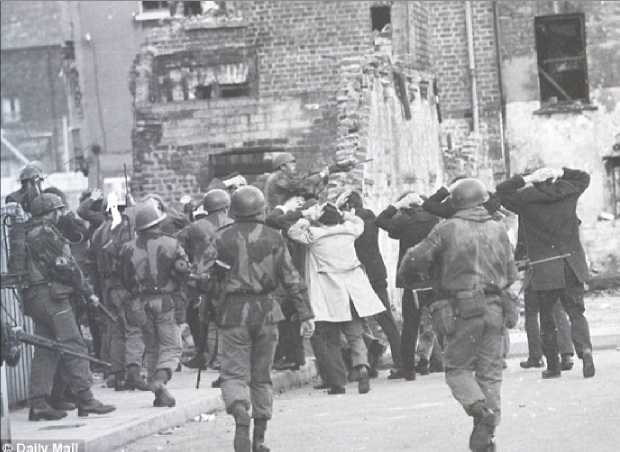
John Molyneux Archive | ETOL Main Page
From Irish Marxist Review, Vol. 7 No. 22, Autumn 2018, pp. 69–70.
Copyright © Irish Marxist Review.
Transcribed & marked up by Einde O’Callaghan for the Encyclopaedia of Trotskyism On-Line (ETOL).
The Impact of the Parachute Regiment in Belfast 1970–1973
by Micheál Smith
Published by The Pat Finucane Centre, August 2018
ISBN: 978-1-5262-0748-7
With excellent timing this publication arrives just when collusion and state-sponsored murder has again come under the international spotlight and when new Garda Commissioner Drew Harris’s role in covering up that collusion (for example in the Miami Showband massacre) ought to be under much more scrutiny than it is.
The recent films No Stone Unturned and Unquiet Graves have exposed the activities of the notorious Glenanne gang, which comprised serving UDR and RUC officers. Members of this gang were responsible for up to 120 deaths, including at Loughinisland and in the Dublin and Monaghan bombings.

|
Now the activities of the Parachute Regiment have come under scrutiny. Two former Paratroopers have been charged in Belfast with the murder of Official IRA activist Joe McCann in 1972. And a new Channel 4 film, The Ballymurphy Precedent, has exposed audiences across Britain to the killings of 11 civilians by the Paras at Ballymurphy, 6 months before many of the same troops killed 13 people on Bloody Sunday. A fresh Inquest recently began in the courts in Belfast into what has become known as the Ballymurphy Massacre.
This short but impactful book opens with an extract from David Cameron’s mealy-mouthed apology for Bloody Sunday in which he said that Bloody Sunday was not “the defining story of the service the British Army gave in Northern Ireland”.
But it was. Bloody Sunday encapsulated the approach of the British army, and particularly the Paras, to Northern Ireland. The Paras were “shock troops renowned for their ferocious attitude to combat”, and coveted as “the Rottweiler of the British Army”, designed and employed to pacify uprisings and terrorise communities.
The book outlines a litany of deaths and abuses for which the Paras were responsible in Belfast from 1970–1973, the peak of the Paras’ deployment there. The author uses contemporary sources, local community-based resources, and very often Paratroopers’ own words to describe these, in sometimes shocking detail.
The book also details the Paras’ massive, sustained assaults on the communities of Ballymurphy, Ardoyne and on the Shankill Road which resulted in multiple injuries and deaths, demonstrating that the Paras’ violence was not reserved solely for one community.
But the key achievement of the book is to place the deployment of the Parachute Regiment in an international context. Smith explores how the Regiment was, after World War 2, “re-positioned as Britain’s shock troops ... at the heart of the violent upheavals as Britain’s grip on its Empire was slipping”.
These were colonial troops, a colonial army, and it treated the conflict in Northern Ireland as a colonial one. Accordingly, it used the same terror tactics as applied in previous colonial campaigns. Smith details how writers and researchers from across the former British Empire are beginning to uncover the secrets of Britain’s dirty wars, particularly through the use of declassified documents as groups like the Pat Finucane Centre have done here.
Smith cites Caroline Elkins, a scholar of the colonial suppression of Kenya, who has described how the architects of British tactics, who positioned the Paras as the spearhead, moved from Malaysia to Kenya to Cyprus to Oman to Northern Ireland, acquiring strategic knowledge and adapting policies to local circumstances. They built a counterinsurgency programme which touched “nearly every corner of the world where Britain had imperial and strategic interests”.
The book also explores how this closer examination of British colonial policy, led by those most affected by it, is forcing a critical reappraisal among historians and academics of recent British and U.S. military strategy in Iraq and Afghanistan.
Perhaps the most stunning details in the book come from the mouths of the Paras themselves. Their pride in their role, in their belief in their innate superiority and their exceptionalism among British troops, is reflected in their memoirs. These expose the brutality, very often the psychopathy, which is prized as a quality in the Parachute Regiment. They are, as one author describes, ‘an elite, hermetic and intensely competitive corps’, ‘a world of complex and often violent ritual’, which takes into its ranks only ‘the most dedicated and aggressive’.
This is emphasised by the gruelling training and indoctrination they endure, which is likewise detailed here. Nevertheless, Smith allows space for one former Para to wonder whether “In any other circumstances my colleagues might have been quite ordinary: perfect gentlemen, good friends, loving husbands, gentle fathers”. Smith asks did the Parachute Regiment create such killers out of young men who otherwise might have been ‘perfect gentlemen, good friends, loving husbands, gentle fathers’, or is it the selection of only ‘the most dedicated and aggressive’ which gives the Regiment its unique character? This document is intended to stand “as evidence of the appalling record of the Parachute Regiment in Belfast but also as testimony to the tenacity and endurance of those largely working-class communities across Belfast who refused to be beaten down”.
Smith has dedicated it to those whose loved ones were killed by soldiers of the Parachute Regiment and to all who were tortured, ill-treated and abused by ‘The Paras’, “wherever they may be”. As he shows, this includes people from across the globe and people who are impacted by the legacy of the Paras’ example today.
John Molyneux Archive | ETOL Main Page
Last updated: 28 December 2022